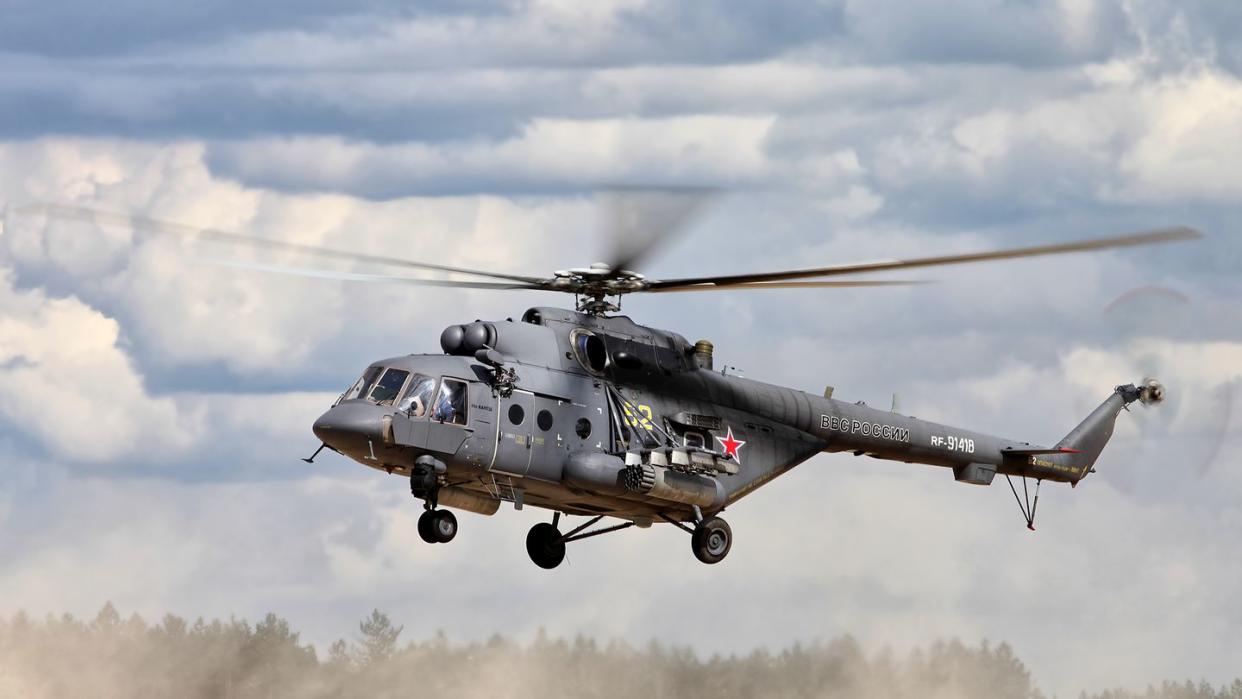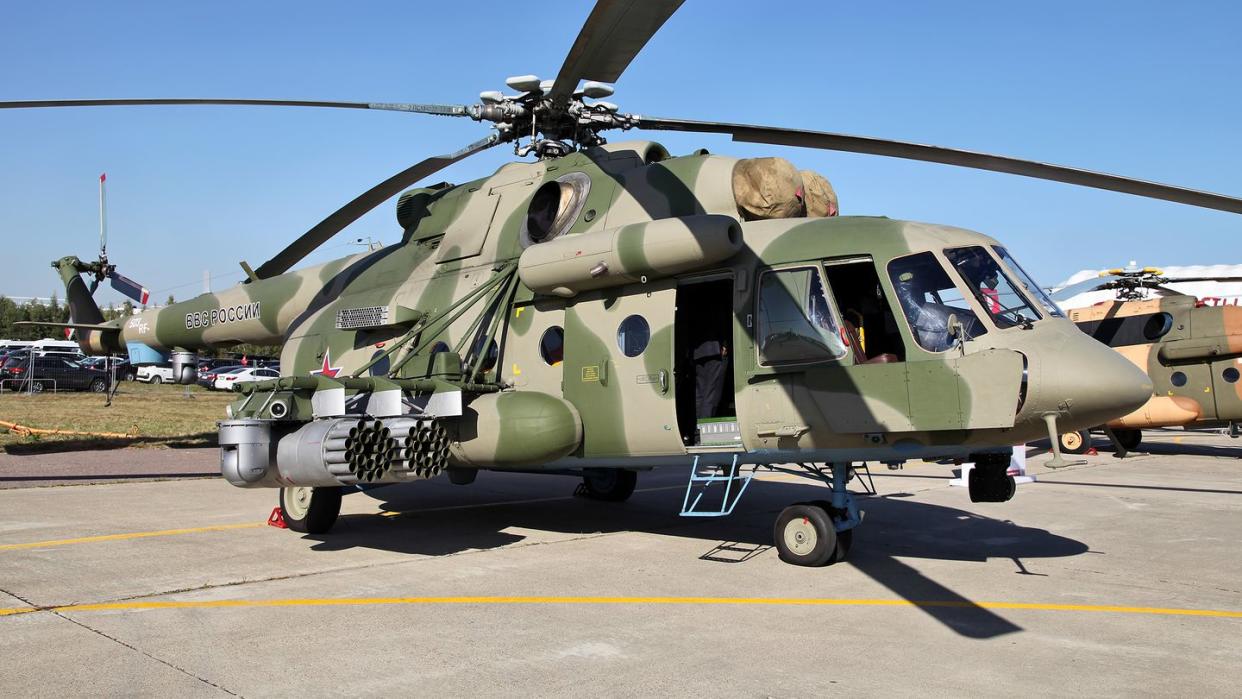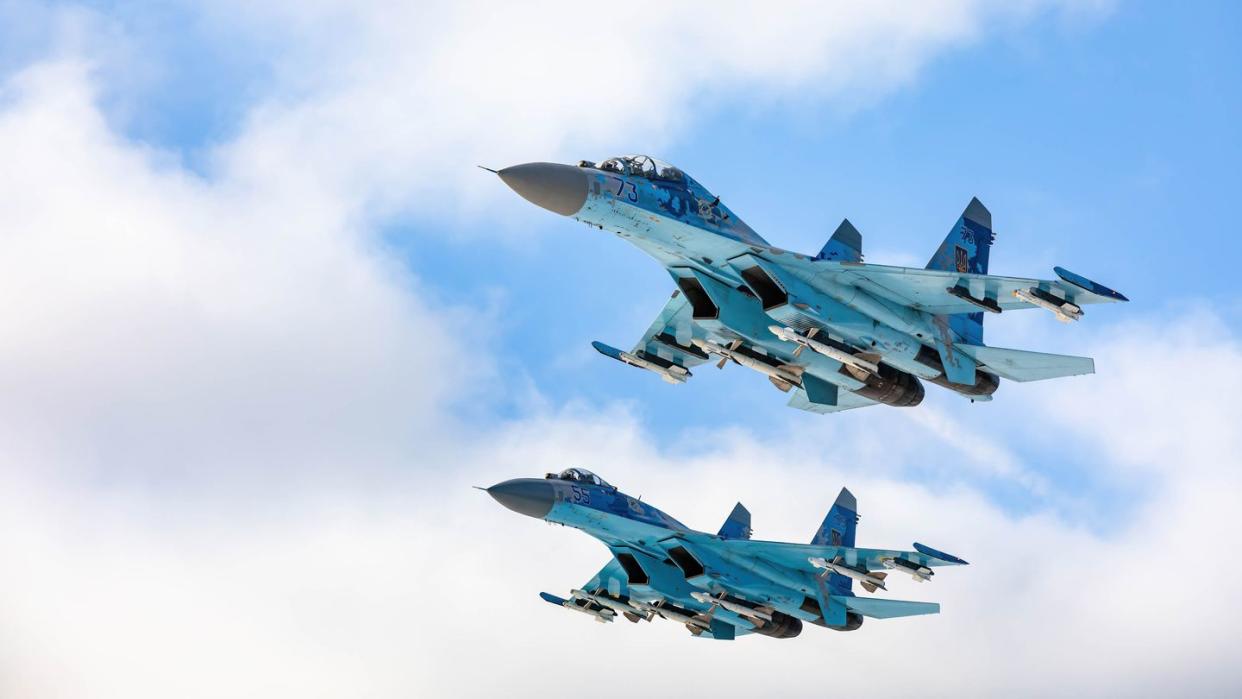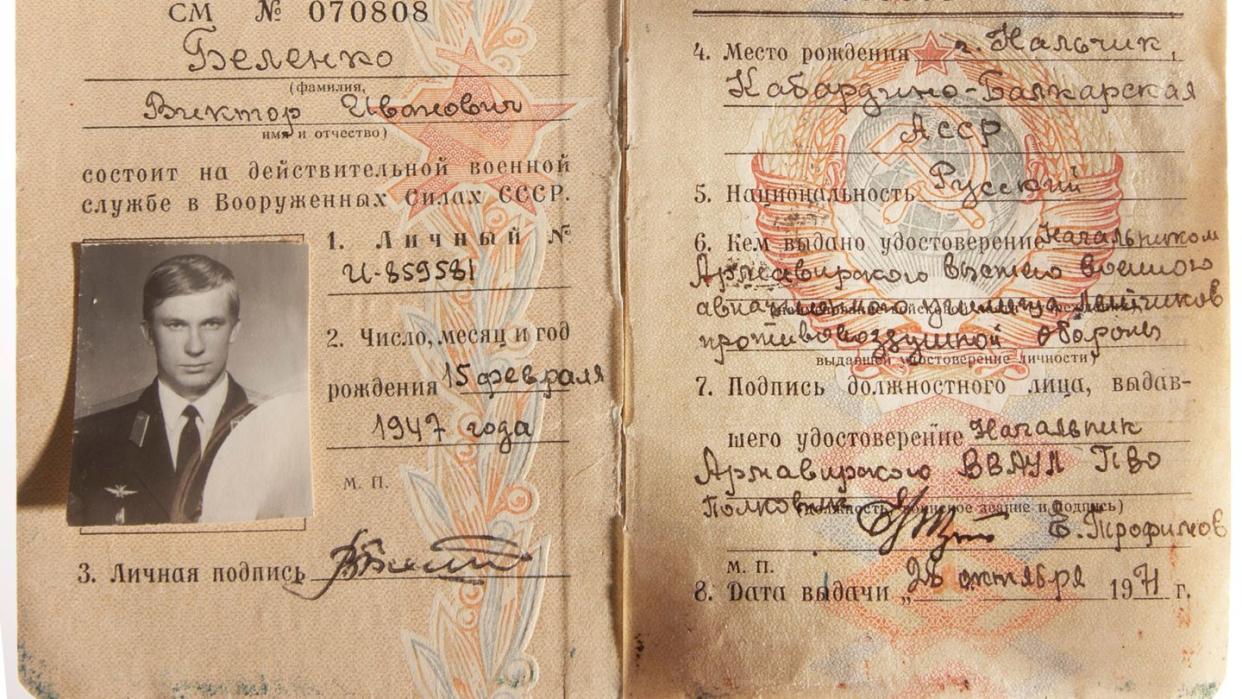A Russian Defector Flew a Chopper Full of Jet Fighter Parts to Ukraine. That's Major.

Last Wednesday, Ukrainian media reported that a Russian helicopter pilot flew his Mi-8AMTSh “Hip-H” assault transport helicopter loaded full of spare parts for jet fighters right into the hands of Ukraine’s military. It was part of a defection operation planned in coordination with the GUR, Ukraine’s military intelligence agency.
The successful caper may be the first defection involving a helicopter operated by Russia’s armed forces.
An article by Ukrainian Pravda indicates that this delicate operation involved six months of planning by Ukraine. The helicopter pilot took off in his aircraft (“Red 62” with serial number RF-04428), which was loaded with spare parts for Su-27 and Su-30SM jet fighters that were intended to be delivered to another Russian airbase.
⚡️The trophy 🇷🇺Russian Mi-8AMTSh b/n 62 red/RF-04428 from the 112th Separate Helicopter Regiment is now in service with the Air Force of 🇺🇦Ukraine
Photo 1 - Summer of 2023, Kharkiv region, Ukraine
Photo 2 - October 6, 2021, Russia pic.twitter.com/ludaoXbfsw— 🇺🇦Ukrainian Front (@front_ukrainian) August 23, 2023
But unbeknownst to his two fellow crew members—presumably a copilot/navigator and flight technician—the pilot set course toward the northeastern Kharkiv region of Ukraine. One assumes that the GUR made arrangements to ensure that the Mi-8 wasn’t engaged by Ukrainian air defenses.
The pilot’s two fellow flight crew were reportedly “eliminated” upon landing. GUR Chief Krylo Budanov told RFE that when the other two crew members “realized where they were sitting, they tried to escape. Unfortunately, they were destroyed, we would like to (take) alive, but we have what we have.”
Photos released by the GUR appear to show bloodstains on aircraft documentation and what may be bullet holes from a shootout. The aircraft has reportedly now been moved to Kyiv.
#Ukraine: A Russian Mi-8AMTSh helicopter (62 Red, RF-92780) was captured by Ukrainian forces as a result of a GUR special operation.
According to 🇺🇦 media the pilot decided to surrender and landed in Kharkiv Oblast- with two crewmembers who were taken unawares later killed. pic.twitter.com/GnZFf0q5Vf— 🇺🇦 Ukraine Weapons Tracker (@UAWeapons) August 23, 2023
The pilot’s family, meanwhile, had reportedly been quietly spirited away to Ukraine in advance of the defection, and would soon be reunited with the defector. Budanov eluded that the defector was in good condition and had “two options,” but had preferred to remain in Ukraine.
Meanwhile, the prominent Fighter Bomber blog tied to Russia’s tactical air force, the VKS, claims that two weeks earlier, a Russian Mi-8 helicopter had mistakenly crossed the border and landed at an airbase in Poltava, Ukraine. In this version, when the crew hurriedly attempted to takeoff, Ukrainian fire then killed two and wounded the pilot.
This Russian blog claims that the incident occurred accidentally due to a failure of the navigation system (perhaps caused by Ukrainian electronic warfare affecting satellite navigation), that the pilot’s family remained in country, and that the planned defection story was invented after the helicopter’s capture.
But if we entertain this account, tricking the pilot into flying more than 180 miles (over an hour’s flight time) into enemy airspace at low altitude without noticing that the land below didn’t correspond to the features on his satellite-navigation system seems like quite a feat. Bear in mind that the Mi-8AMTSh has a maximum speed of 155 miles per hour and range of 360 miles.
How significant is the captured Mi-8AMTSh?
The Mi-8 ‘Hip’ medium-lift twin-engine helicopter has been a workhorse of Russia’s vertical-lift aviation since it entered Soviet service in 1967. It remains in production today, with over 17,000 built—in dozens of different models—and in the service of over 50 countries, including some U.S. government agencies.
Both Ukraine and Russia actively employ Mi-8s in support and ground attack roles—the latter usually involving rocket barrages released in an arc at extremely low altitude. Early in the war, Russia used Mi-8s to insert troops in costly air assault landing operations, while Ukraine’s flew risky night missions over Russian lines to resupply the surrounded garrison of Mariupol and evacuate wounded.
Ukrainian Mi-8s still doing low-level Ukrainian Mi-8 things (lobbing S-8 80mm unguided rockets at Russian positions).#Ukraine#UkraineWar@Osinttechnical pic.twitter.com/nAxa3rV5Ic
— NewsUkrainian24 (@NewsUkrainian24) June 12, 2023
The Mi-8AMTSh sub-model captured this week will likely have bits of newer technology of interest to Ukrainian and Western intelligence services, as it is the latest air-assault variant of the Mi-8, which entered service in 2009. That means it’s armed and armored to deploy infantry directly into combat while supporting them with its own firepower.

The AMTSh can carry 26 fully-equipped infantry, or over 4 tons of cargo, and features an additional right-side door and more convenient rear ramp to allow faster unloading than the Mi-8’s usual clamshell rear doors. Meanwhile, the six rails on the AMTSh’s stub-wings can carry 9M120 Ataka radio-guided anti-tank missiles, 80-millimeter rocket pods, podded machine guns, or 23-millimeter autocannons. A handful of Mi-8s have also been upgraded with Vitebsk self-defense, which includes a missile approach warning sensor and multiple laser turrets that can blind approaching infrared guided missiles.
AMTShs can also carry up to two sideways-facing window-mount 7.62-millimeter machine guns, ideal for providing covering fire while descending on a landing zone.
Other features include redesigned rotors and VK-2500 turboshaft with digital engine controls that improve hot climate and high altitude performance, modern cockpit displays to support night flying, GPS/GLONASS satellite navigation, and beefed-up armor plating around the engine and cockpit. Russia’s Air Force may have received between 100 and 200 Mi-8AMTShs out of around 780 Mi-8s in service.
Including the defector’s ‘Hip,’ photos confirm that Russia has lost at least 20 Mi-8 transports (many early in the war), as well as four Mi-8MTPR-1 electronic warfare helicopters used for jamming. Ukraine has also lost 20 Mi-8s, but has received or been pledged 44 Mi-8s and Mi-17s (the export model designation for Mi-8Ms with uprated engines).
Once analysts are done picking over the most interesting technology (particularly sensors and self-defense systems), this helicopter will reportedly serve in the Ukrainian military—service with the potential to be colorful, given its more advanced capabilities than the Mi-8s already in Ukrainian service.
The Su-27 and Su-30SM components being transported will also likely interest Ukrainian and Western analysts, particularly if any relate to the aircraft’s sensors, weapons, or self-defense systems. Data obtained could potentially aid in detecting, classifying, and overcoming the defenses of those aircraft types. The older Su-27 ‘Flanker’ parts may even be directly applicable to sustaining Ukraine’s fleet of Su-27 fighters.

However the defection’s impact may primarily be on morale—revealing that a pilot in Russia’s military was sufficiently demoralized by the war to take on the considerable risks of defection in wartime. His stated reasons for doing so will be of particular interest, should they surface to the public. The incident may also trigger internal ripples of doubt concerning the loyalty of other Russian military pilots, which could lead to crack downs and disruptions to the pilot roster.
A legacy of defections
During the Cold War, several Communist pilots—often motivated by lucrative cash prizes advertised by Western-allied intelligence agencies—were enticed into flying over to the West, bringing with them state-of-the-art MiG-15, MiG-25 and MiG-29 jet fighters that were hungrily snapped up for analysis.

It’s claimed that Ukraine’s captured ‘Hip’ is the first helicopter lost by the Soviet/Russian military to defection. That may be, though both a Hip helicopter and two Mi-24 Hind gunships supplied to the communist-backed Afghan Air Force did defect to Pakistan in the 1980s.
The particular context that facilitated the luring elite pilots into defecting with their advance planes may have ended with the dissolution of the Soviet Union, but Russia’s invasion of Ukraine in 2014 saw those circumstances reemerge. Initially, Russia targeted Ukrainian pilots, having already secured the defection of many Ukrainian Navy personnel when it seized Crimea in 2014.
Ukrainian military historian Mikhail Zhirokov wrote that Russian intelligence successfully contacted one Ukrainian pilot during the brief Minsk quasi-truce in the fall of 2014.
While flying a surveillance mission along the Russian border over the Sumy region of Ukraine on September 8, 2014, this pilot seemingly attempted to fly his Su-24MR supersonic reconnaissance jet to Russia’s Khalino Airbase not far across the border—but was stopped at the intervention of the navigator sitting beside him and returned to base.
After Russia’s full-scale invasion in 2022, Ukraine’s parliament approved legislation offering $1 million to Russian pilots who defected with their aircraft.
Ukraine’s intelligence service pursued its own operation, contacting Russian bomber pilots flying Su-24s, Su-34 and Tu-22Ms in a bid to entice defection. A few played along, but only because Russia’s own intelligence service was hoping to lure the Ukrainian agents into their own trap—a scheme that the Ukrainian agents detected in turn. After feeding disinformation back, the Ukrainian agents thought that they had secured the defection of a Russian bomber pilot named Nosenko, who promised to land at Kanatovo airfield on the morning of July 23.
Flying towards the base, however was not one defecting plane, but eight Kalibr and Kh-22 cruise missiles. These missiles killed one Ukrainian, injured 17, and destroyed two combat aircraft. Afterwards, the Ukrainian government tried a former intelligence agent involved in the defection effort for conducting the operation without authorization.
Ukraine’s Mi-8AMTSh caper clearly worked much better for Ukraine’s intelligence service, achieving another win for Ukraine on the same day that the country knocked out an important S-400 air defense battery in Crimea. Russia, meanwhile, fired air force chief General Surovikin and appears likely to have assassinated mercenary warlord Yevgeny Prigozhin in his private jet, along with nine other passengers onboard.
You Might Also Like
